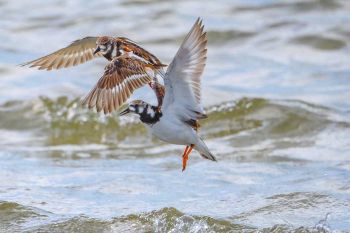Alternative name: Turnstone
- Arenaria interpres
Identification
Length 21–26 cm (8¼-10¼ in), wingspan 50–57 cm, weight 84–190 g
- Relatively small and stocky
- Short orange legs
- Short, sharp black bill
- Bib black with white half-collar during breeding (April-September), all dark brown in winter
- White underparts, central lower back and rump, and base of tail
- In flight, wings dark brown with a white wingbar and a white scapular bar; secondary coverts reddish in summer plumage
- Head white with black mask and blackish crown streaks during breeding, all dark brown in winter
- Upperparts mottled reddish brown and black during breeding, dark brown in winter
- Sexes similar, though males brighter than females in summer plumage (slightly more white on head, brighter rufous upperparts)
- Juvenile similar to winter adult
The summer breeding plumage (from which it gets its name 'ruddy') can be seen for a month or so (mid April to mid May) before they migrate to the Arctic to breed, and again for a month after they return in late summer (August).
Similar species
Black Turnstone, which occurs with Ruddy Turnstone on the west coast of North America, is structurally very similar, but marginally larger; it is much darker blackish-brown, and in the breeding season has less white on the head, only a small white spot at the base of the bill and a weak white eyebrow. Its legs are also dark brown, rather than orange.
Distribution
A widely distributed species along shorelines of continents. Breeds on tundra in the extreme northern latitudes of North America, Europe, and Russia; also a small relict population further south in the Baltic Sea and islets in eastern Denmark.
Overwintering range on coasts almost worldwide. Generally rare inland and on fresh water, but fairly common on the shores of the Great Lakes of North America during migration.
Taxonomy
Formerly considered a plover, it is now classified in the sandpiper family.
Subspecies
There are two subspecies[1]:
- A. i. interpres:
- Far northeastern Canada, Greenland, and across northern Eurasia to northwestern Alaska; winters western Europe to Africa and Australasia, also a few on west coast of North America.
- A. i. morinella:
- North-eastern Alaska east to north-central Canada; winters southeastern USA to southern South America. Slightly smaller than A. i. interpres.
Habitat
Rocky shores. Marshy lowland slopes, and tundra. Casual inland on migration.
Behaviour
Fairly long-lived, with an average around 9 years and a recorded record of 22.
A strong flier that during migration is able to fly from southern Australia to Taiwan in one stretch.
Diet
The action of flipping over small stones to find food led to its common name. It will take just about anything organic, including insects, carrion, molluscs, eggs, worms, etc.
Breeding
Monogomous. Individual birds often return to favourite spots year after year.
Vocalisation
A long rapid trill.
References
- Clements, J. F., T. S. Schulenberg, M. J. Iliff, S. M. Billerman, T. A. Fredericks, B. L. Sullivan, and C. L. Wood. 2019. The eBird/Clements Checklist of Birds of the World: v2019. Downloaded from http://www.birds.cornell.edu/clementschecklist/download/
- Nettleship, D. N. (2020). Ruddy Turnstone (Arenaria interpres), version 1.0. In Birds of the World (S. M. Billerman, Editor). Cornell Lab of Ornithology, Ithaca, NY, USA. https://doi.org/10.2173/bow.rudtur.01
- Collins Field Guide 5th Edition
- Birdforum thread with link to migration study
Recommended Citation
- BirdForum Opus contributors. (2025) Ruddy Turnstone. In: BirdForum, the forum for wild birds and birding. Retrieved 9 May 2025 from https://www.birdforum.net/opus/Ruddy_Turnstone
External Links
GSearch checked for 2020 platform.1






